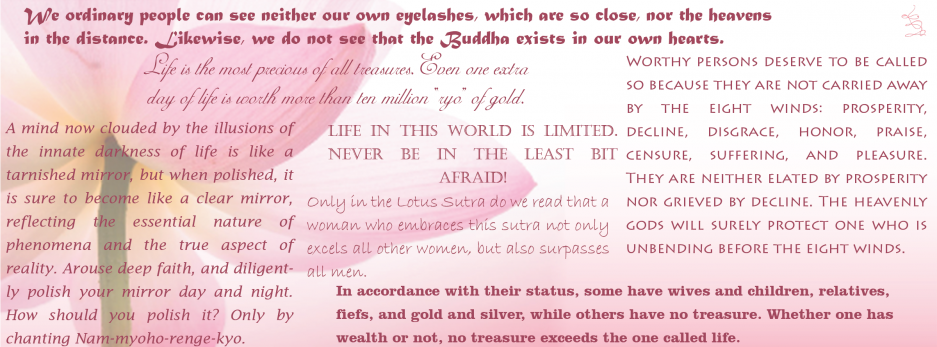Tags
Gosho, Lotus Sutra, Nichiren Buddhism, Nichiren Daishonin, The Actions of the Votary of the Lotus Sutra, The devil king, The four devils, The three obstacles, Votary
The fifth volume of Great Concentration and Insight states, “As practice progresses and understanding grows, the three obstacles and four devils emerge in confusing form, vying with one another to interfere.” It also states, “It will only be like a boar rubbing against the golden mountain; like the various rivers flowing into the sea; like logs making a fire burn more briskly; or like the wind swelling the body of the kālakula insect.” These passages mean that, if one understands and practices the Lotus Sutra just as it teaches, in accordance with the people’s capacity and at the right time, then these seven obstacles and devils will confront one. Among them, the devil king of the sixth heaven[is the most powerful. He] will possess one’s sovereign, parents, wife or children, lay supporters, or evil persons, and through them will attempt in a friendly manner to divert one from one’s practice of the Lotus Sutra, or will oppose one outright. The practice of Buddhism is always accompanied by persecutions and difficulties corresponding in severity to whichever sutra one may uphold. To practice the Lotus Sutra will provoke particularly harsh persecutions. To practice as it teaches, and in accordance with the time and the people’s capacity, will incite truly agonizing ordeals.
This work is an autobiographical account covering the events of an important period in Nichiren Daishonin’s life—from the time shortly before the Tatsunokuchi Persecution through his two-and-a-half-year exile on Sado Island to his eventual retirement to Mount Minobu. In the course of his struggles over this period of nine years, the Daishoninfulfilled the predictions in the Lotus Sutra concerning its votary and established himself in both word and deed as the Buddha of the Latter Day of the Law.
This letter was written in the second year of Kenji (1276) and addressed to the lay nun Kōnichi, a widow who lived in Awa, the Daishonin’s native province. Her son had earlier converted to the Daishonin’s teachings, and through him she herself became a convert. Some time after her conversion, her son died. But she overcame her deep sorrow and remained a sincere p.780believer in the Daishonin’s Buddhism to the end of her life.
Quoting the Great Teacher T’ien-t’ai, Nichiren Daishonin states that as a votary’s practice grows, the three obstacle and four devils will surely interfere in one’s journey towards Buddhahood . The “three obstacles and four devils” symbolize the internal and external functions that impede our progress toward genuine happiness, or enlightenment.
Nichiren reiterates that these hindrances emerge “in confusing form,” which means that their influence is usually not obvious or easy to recognize. We should be diligent in learning how to identify them and in developing the strength to win over them. Otherwise, we risk being “frightened” or “influenced” by these negative functions, allowing them to cloud our Buddha nature and obstruct our Buddhist practice.
The three obstacles are:
- the obstacle of earthly desires;
- the obstacle of karma (the negative actions or offenses we commit in this life); and
- the obstacle of retribution (the negative effects of our actions in past lives, or karma).
The four devils are:
- the hindrance of the five components—hindrances caused by one’s own physical and mental functions;
- the hindrance of earthly desires—hindrances arising from greed, anger and foolishness;
- the hindrance of death—one’s own untimely death obstructing one’s Buddhist practice or doubts arising from the untimely death of a fellow practitioner; and
- the hindrance of the devil king of the sixth heaven—a strong negative influence taking various forms to cause practitioners to discard their Buddhist practice.
The three obstacles and four devils are functions that sap the bright, positive life condition we gain from our practice; they weaken our spirit to fight for our own happiness and that of others, leaving us with diminished courage and wisdom. In particular, the devil king of the sixth heaven is described as being most powerful. It represents negative functions that can operate through influential people in our environment to discourage us from pursuing our Buddhist practice and keep us in a place of victimhood and suffering. The function arises from the human tendency to be ignorant of the fundamental dignity of life and to deny the noble potential for Buddhahood that all people possess. That tendency or ignorance is known as fundamental darkness. But more important than wondering what category of obstacle or devil our problems fall into is to recognize those things that hinder our Buddhist practice and challenge them with faith, prayer and action. Lasting happiness can be achieved through learning to win over our inner darkness, or ignorance. SGI President Ikeda explains: “Buddhism is a struggle between the Buddha and the devil. It is by drawing out into the open, battling and defeating the three obstacles and four devils that we ourselves can become Buddhas”
By continuously engaging in this challenge to activate our fundamental enlightenment, we can forge an indestructible foundation of happiness. When obstacles and devilish functions emerge, that is exactly the time to fight to change our karma and to win for the sake of our happiness. As Nichiren writes, “The three obstacles and four devils will invariably appear, and the wise will rejoice while the foolish will retreat” (“The Three Obstacles and Four Devils,” WND-1, 637). Urging us to never retreat, he calls on us to joyfully challenge and overcome our problems. The wise rejoice because they know that obstacles and opposition are the resistance that makes it possible for them to achieve enlightenment.

Pingback: LETTER TO THE BROTHERS | A Gosho A Day
Pingback: A Gosho A Day